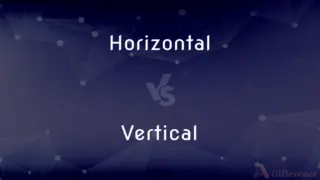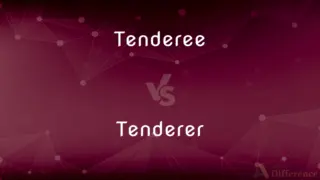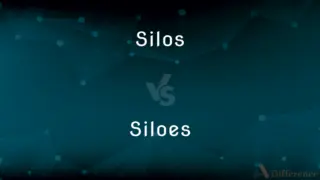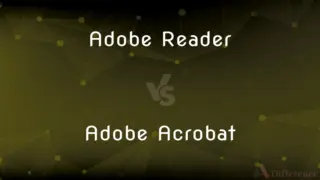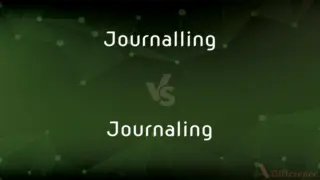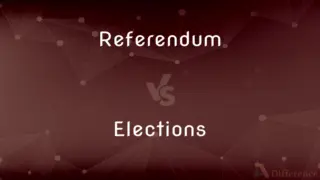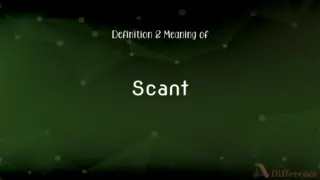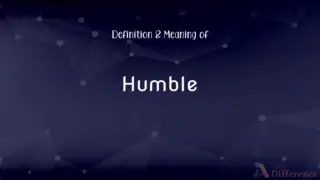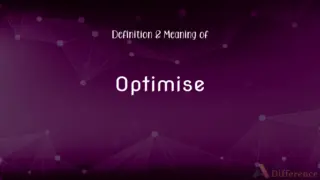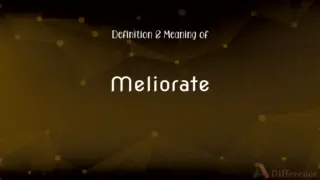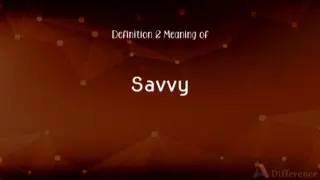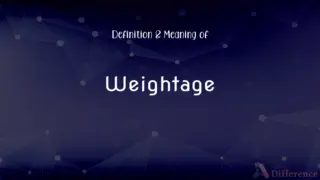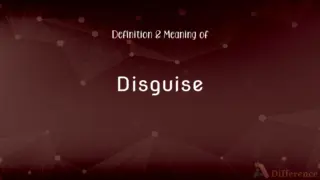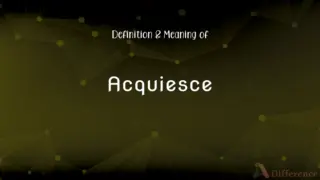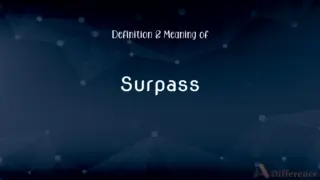Embedding vs. Imbedding — What's the Difference?
By Tayyaba Rehman & Maham Liaqat — Published on December 16, 2024
Embedding and imbedding are variations of the same concept, referring to the act of fixing something firmly and deeply within a surrounding mass. "Embedding" is the more commonly used term, especially in technical and scientific contexts.
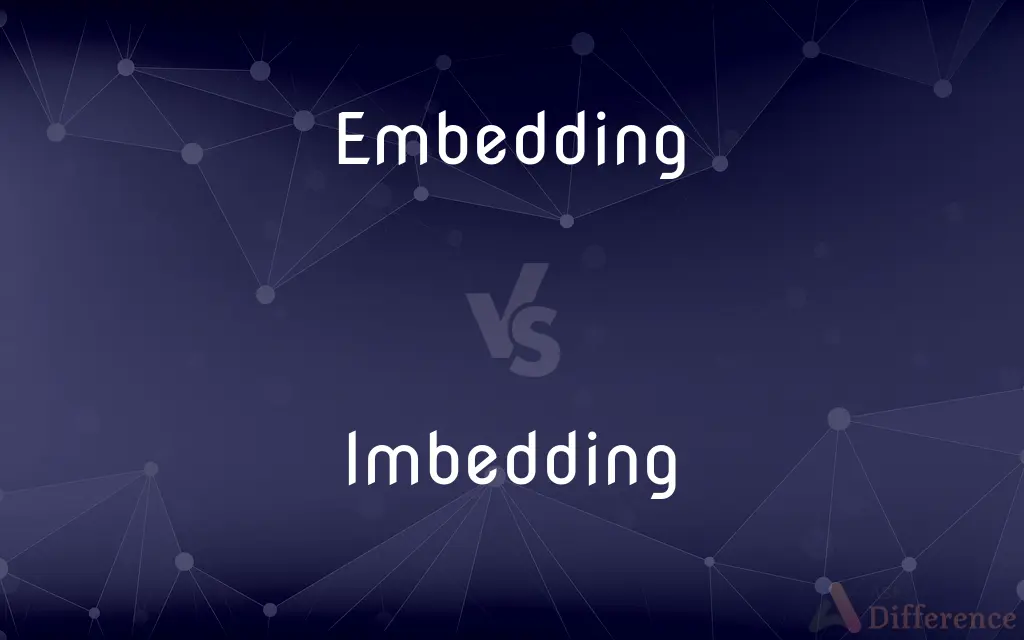
Difference Between Embedding and Imbedding
Table of Contents
ADVERTISEMENT
Key Differences
The terms "embedding" and "imbedding" essentially refer to the same process: placing or fixing an object deeply and securely within another object or medium. "Embedding" is the preferred spelling in most contexts, reflecting its widespread usage in technology, science, and everyday language. It is commonly used to describe the integration of elements such as videos or images into web pages, or the incorporation of materials within a solid matrix in scientific procedures.
"Imbedding," while less common, is considered an acceptable variant. It appears in various texts and can be found in certain English dialects. The choice between "embedding" and "imbedding" often comes down to stylistic preference or regional spelling conventions. However, "embedding" is more universally recognized and is more likely to be found in formal and technical writing.
Both terms share the same grammatical functions, able to be used as nouns (embedding/imbedding) or as verbs (to embed/to imbed). Despite the difference in spelling, there is no difference in meaning or application. The choice between these terms does not affect the understanding of the concept they describe.
While "embedding" is the dominant form and is preferred in technical disciplines and formal writing, while "imbedding" remains a valid variant. The consistency in spelling within a document or publication is key, ensuring clarity and professionalism in communication.
Comparison Chart
Spelling
More commonly used, especially in technical contexts.
Less common variant.
ADVERTISEMENT
Usage
Preferred in technology, science, and formal writing.
Appears in various texts, certain dialects.
Meaning
Act of fixing something firmly within something else.
Same as "embedding".
Context
Used universally across different fields.
Used based on stylistic preference or region.
Recognition
More universally recognized and accepted.
Accepted but less likely to be used in formal contexts.
Compare with Definitions
Embedding
Inserting data or objects into a larger structure.
The software supports embedding custom code into the template.
Imbedding
Another way of inserting objects into structures.
Imbedding stones into the walkway added aesthetic value.
Embedding
Integrating a component within another system.
The website allows embedding videos directly into posts.
Imbedding
Another method of encapsulating substances.
The process of imbedding specimens can preserve them for years.
Embedding
Encapsulating a substance within a solid material.
Embedding tissues in paraffin is a step in histological studies.
Imbedding
Another expression for establishing deeply.
The traditions are imbedding in the culture of the community.
Embedding
Establishing deeply in a particular environment.
Her experiences were deeply embedding in her memory.
Imbedding
Another form of integrating components.
Imbedding links in the document improved its interactivity.
Embedding
Incorporating seamlessly into a larger context.
Embedding renewable energy solutions into urban planning is crucial.
Imbedding
Another approach to incorporation.
The strategy involves imbedding sustainable practices in daily operations.
Embedding
To fix firmly in a surrounding mass
Embed a post in concrete.
Fossils embedded in shale.
Imbedding
To fix firmly in a surrounding mass
Embed a post in concrete.
Fossils embedded in shale.
Embedding
To become embedded
The harpoon struck but did not embed.
Imbedding
To cause to be an integral part of a surrounding whole
"a minor accuracy embedded in a larger untruth" (Ian Jack).
Embedding
One that is embedded, especially a journalist who is assigned to an active military unit.
Imbedding
To become embedded
The harpoon struck but did not embed.
Embedding
The act or process by which one thing is embedded in another.
Imbedding
One that is embedded, especially a journalist who is assigned to an active military unit.
Embedding
Present participle of embed
Common Curiosities
Is there a difference in meaning between embedding and imbedding?
No, there is no difference in meaning; they are variations of the same term.
How does the choice between embedding and imbedding affect readability?
The choice doesn't significantly affect readability, but "embedding" may be more immediately recognized by a broader audience.
Can I use both "embedding" and "imbedding" interchangeably in a document?
While both terms are correct, it's best to stick with one spelling for consistency within a single document.
What is the historical origin of the difference in spelling?
Variations in spelling often arise from historical usage patterns, printing practices, or regional preferences, which is likely the case with "embedding" and "imbedding."
Does the spelling variant affect search engine optimization (SEO)?
Yes, since "embedding" is more commonly used, it may be a better choice for SEO purposes to match common search queries.
Which term should I use in a scientific paper?
"Embedding" is preferred in scientific and technical contexts for its widespread acceptance and recognition.
Is "imbedding" considered incorrect in academic writing?
No, "imbedding" is not incorrect, but "embedding" is the preferred term in academic and professional settings.
Can the use of "imbedding" in a document be a reason for editorial correction?
It might be corrected for consistency or to align with the preferred terminology in specific fields, especially in formal publications.
Are there any contexts where "imbedding" is preferred?
"Imbedding" might be preferred in certain regions or by individual authors for stylistic reasons, but there are no specific rules dictating its use.
Why is "embedding" more common than "imbedding"?
"Embedding" has become the standard form in most English-speaking regions and fields, likely due to usage trends and acceptance in technical literature.
Has the preference for "embedding" over "imbedding" changed over time?
Yes, language usage evolves, and "embedding" has become the dominant form over time, reflecting current preferences and standards.
Are there any tools or references that recommend one spelling over the other?
Style guides, dictionaries, and publication guidelines often recommend "embedding" due to its prevalence in contemporary usage.
How can I ensure consistency in spelling throughout a large document or series of publications?
Using a style guide or editing software can help maintain consistency in terminology and spelling across documents.
How should I decide which term to use in my writing?
Consider your audience, the convention in your field, and consistency with the rest of your document when choosing which term to use.
Is the choice between these terms significant in legal or technical documents?
In legal or technical documents, clarity and adherence to standard terminology are crucial, making "embedding" the safer choice.
Share Your Discovery
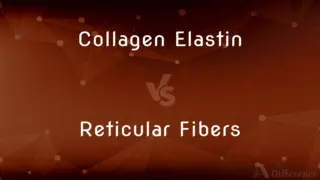
Previous Comparison
Collagen Elastin vs. Reticular Fibers
Next Comparison
Managers vs. LeadersAuthor Spotlight
Written by
Tayyaba RehmanTayyaba Rehman is a distinguished writer, currently serving as a primary contributor to askdifference.com. As a researcher in semantics and etymology, Tayyaba's passion for the complexity of languages and their distinctions has found a perfect home on the platform. Tayyaba delves into the intricacies of language, distinguishing between commonly confused words and phrases, thereby providing clarity for readers worldwide.
Co-written by
Maham Liaqat
